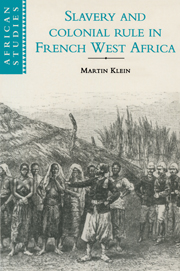Book contents
- Frontmatter
- Contents
- List of illustrations
- List of maps
- List of tables
- Preface
- List of abbreviations
- Glossary
- 1 Slavery in the Western Sudan
- 2 Abolition and retreat. Senegal 1848–1876
- 3 Slavery, slave-trading and social revolution
- 4 Senegal after Brière
- 5 Conquest of the Sudan: Desbordes to Archinard
- 6 Senegal in the 1890s
- 7 The end of the conquest
- 8 The imposition of metropolitan priorities on slavery
- 9 With smoke and mirrors: slavery and the conquest of Guinea
- 10 The Banamba Exodus
- 11 French fears and the limits to an emancipation policy
- 12 Looking for the tracks. How they did it
- 13 After the War: renegotiating social relations
- 14 A question of honor
- Appendixes
- Notes
- Bibliography
- Index
- Titles in the series
12 - Looking for the tracks. How they did it
Published online by Cambridge University Press: 07 May 2010
- Frontmatter
- Contents
- List of illustrations
- List of maps
- List of tables
- Preface
- List of abbreviations
- Glossary
- 1 Slavery in the Western Sudan
- 2 Abolition and retreat. Senegal 1848–1876
- 3 Slavery, slave-trading and social revolution
- 4 Senegal after Brière
- 5 Conquest of the Sudan: Desbordes to Archinard
- 6 Senegal in the 1890s
- 7 The end of the conquest
- 8 The imposition of metropolitan priorities on slavery
- 9 With smoke and mirrors: slavery and the conquest of Guinea
- 10 The Banamba Exodus
- 11 French fears and the limits to an emancipation policy
- 12 Looking for the tracks. How they did it
- 13 After the War: renegotiating social relations
- 14 A question of honor
- Appendixes
- Notes
- Bibliography
- Index
- Titles in the series
Summary
… knowledge of all human activities in the past as well as the great part of those in the present is … a knowledge of their tracks.
Marc Bloch… The slaves of Kayor were not happy men, but they knew when and how to seize a chance.
Donal Cruise O'BrienMost slaves did not leave. I have several times tried to estimate the number of those in slavery and the number of those who left. Igor Kopytoff has used estimates made by me to minimize the importance of the exodus and to underline that most slaves chose not to leave. We differ in how important we consider a movement of probably over a million people and what that movement meant to slave systems, but in one way, he is right. Most slaves did not leave; probably somewhat over a third did. Leaving was not easy. Nobody was offering to help slaves, and where the masters were able to do so, they were willing to coerce. Most important, the exodus involved a long walk home. Slaves often owned nothing but what they could carry with them and in most cases that was very little. For those going from the Sahel to the southern savanna, it was usually a walk of twenty to thirty days. It was about 230 km from Banamba to Buguni, more than double that from Nioro, and even further for Gurunsi slaves returning from desert-side areas. Furthermore, they had no idea what they would find when they got home. If they could get land and seed, it was three months from planting to harvest.
- Type
- Chapter
- Information
- Slavery and Colonial Rule in French West Africa , pp. 197 - 215Publisher: Cambridge University PressPrint publication year: 1998
- 1
- Cited by

